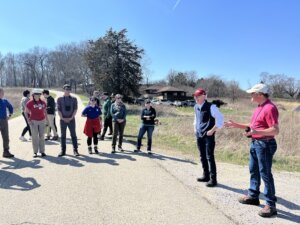In a story for Wisconsin Public Radio, Colleen Leahy spoke with Dr. Adena Rissman about the executive order Governor Tony Evers issued on Earth Day, pledging to conserve 125,000 acres of forest land and plant 75 million trees by the end of 2030 to fight climate change.
Dr. Rissman, a faculty member of the Forest and Wildlife Ecology Department at UW-Madison, said that although it can’t be the only solution, planting trees is a great tool in mitigating climate change.
“The estimates vary, but it seems like maybe we could do 10, 20, 30 percent of what we need to do by how we treat the natural world,” Dr. Rissman says. “Tree planting is an important part of that.”
There are also additional benefits to planting trees. Dr. Rissman says that most trees in Wisconsin are about 80 years old, from forests that regenerated during the 1920s and 1930s. Creating a more diverse age structure will help provide different kinds of habitat. Similarly, planting a variety of tree species will help forests as a whole adapt to changing temperatures, fluctuating rainfall, and new threats from diseases and pests.
While Governor Evers’s 75 million new, young trees will provide big benefits, Dr. Rissman also emphasizes the importance of preserving our existing woodlands.
“One of the other exciting parts about this proposal is that it has a commitment to keeping forests as forests,” Dr. Rissman says. This benefits not only wildlife and recreation, but also Wisconsin’s $24 billion forest industry, which often relies on state or county forests for long-term timber availability and sustainable management.
“We’ve done a lot of conservation projects over the decades, and this is an effort to grow on what are really fairly bipartisan efforts to ensure that [we preserve] industrial forestland that can continue to be a base of forest products to keep our mills going, that also provides all the other benefits of forests–wildlife, water quality, recreation, and carbon storage,” Dr. Rissman says.
But she notes that these ongoing efforts are threatened by the potential loss of state funding for conservation programs.
“One of the things that has been discussed a lot recently is the upcoming budget in Wisconsin and whether there will be funds for things like the Knowles-Nelson Stewardship Program,” Dr. Rissman says, “which is really needed if we want to have this goal of conserving forests.”
Featured image by Joshua Mayer, 2010.










